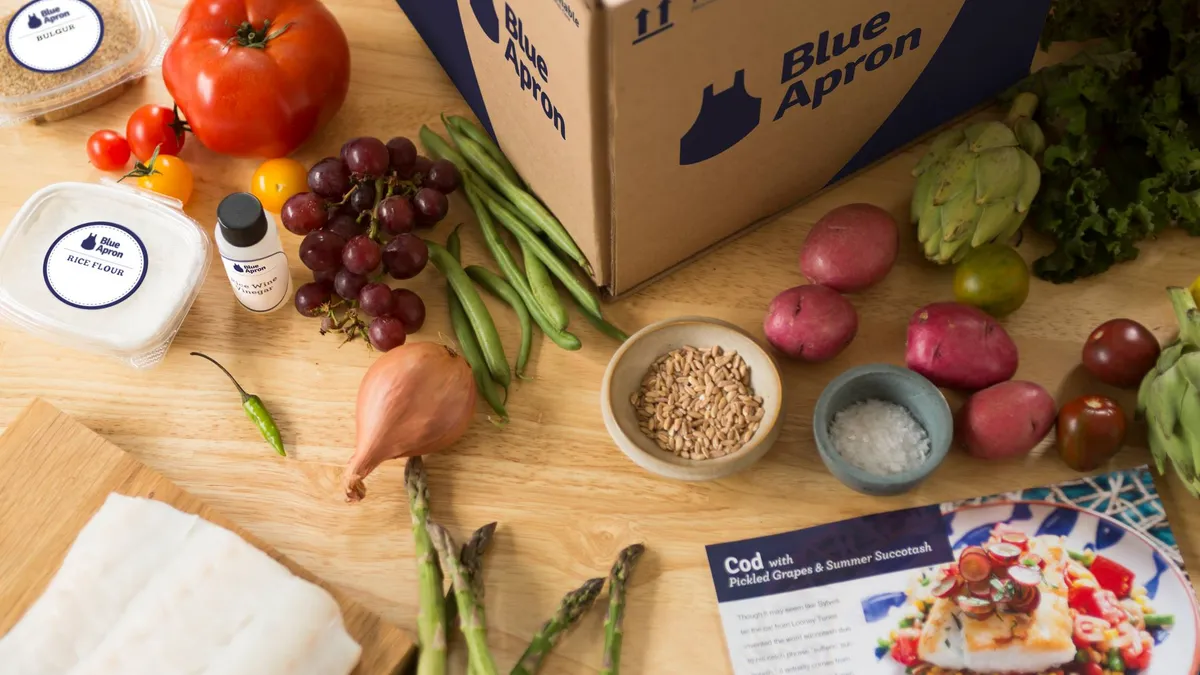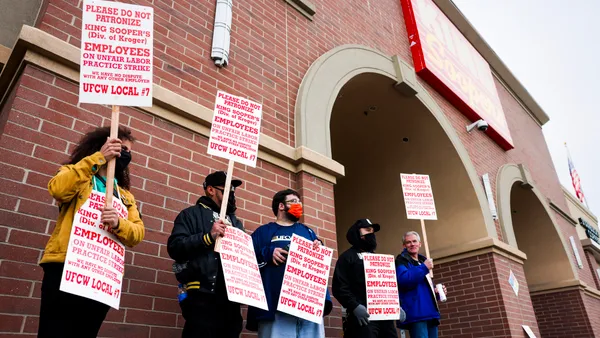Dive Brief:
- Blue Apron posted sales of $179.6 million during the second quarter, trailing analyst estimates, compared to $238.1 million in the same period a year ago as fewer customers used the meal kit service. It lost $32.8 million during the quarter versus $31.6 million in the second period of 2017.
- The New York company said customers using the service declined by 24%. Shoppers purchasing its preportioned meals dropped to 717,000 from 786,000 in the first quarter and 943,000 a year ago. The average order value also dropped slightly from a year ago to $57.34.
- In a conference call, Bloomberg reported that Blue Apron said it expects revenue of $150 million to $160 million in the third quarter, a 24% decline from the year-earlier period. Analysts’ had been expecting $204.3 million.
Dive Insight:
Blue Apron's challenging quarter is another reminder that while meal kits have a future in the food space, the segment remains ripe for change and eventual consolidation among the remaining players is all but inevitable.
In a statement, Blue Apron CEO Brad Dickerson called 2018 "a year of transition and building for the future” — words that investors and analysts dread hearing for a company that has struggled mightily since it went public just over a year ago.
During the second quarter, Blue Apron saw a sharp drop in orders and customers, both key metrics that are vital toward helping it achieve stability and potential profitability in its business. There were some reasons for optimism, too. Orders per customer and average revenue per customer were both unchanged from the first quarter, a sign that people who are sticking around remain loyal to the meal kit company and consistent in their buying habits.
Blue Apron said while marketing expenses remained relatively flat at $34.6 million from the same time a year ago, they also grabbed a larger percentage of net revenue (19.3% compared to 14.5%) as the company looked to promote its brand through online advertising and other channels. After starting online, some companies like Blue Apron and Hello Fresh have worked aggressively to expand their reach into retail outlets in an effort to grab customers who may not always want to purchase a kit online in advance or dislike being tied to a subscription service.
Other retailers have spent millions of dollars to purchase already established meal kit companies. Kroger acquired Home Chef in May. And Albertsons' purchased Plated in September after research from the grocer showed 80% of its customers said they wanted meal kits in stores. Blue Apron announced in May that it launched a pilot program with Costco to carry its product.
With a low barrier for entry, the meal kit market has become infiltrated with more than 150 companies, according to Packaged Facts. Max Dresse, associate director of product innovation with HelloFresh US, said at a conference panel last month on meal kits that within five years, there will be between three and five meal kit providers dominating the market as some of the smaller players today go out of business or are acquired.
"Quite frankly, it is a difficult business model. To be profitable in that space requires a lot of discipline, requires a lot of knowledge when it comes to your operations," Dresse said. "We've seen with some of our competitors that they are really struggling on the operational side, so what we believe in this space is that there is going to be less and less brands."
There are already signs of a shakeout in meal kits. In July, Chef'd briefly shut down after running out of cash and failing to secure additional funding. It ended up finding a buyer and will now focus on grocery stores. In addition to Chef'd, former meal kit companies Sprig, SpoonRocket and Maple Food have collapsed. With sales growth slowing in the sector, that could put pressure on the weaker companies that remain to improve their businesses, find buyers or be forced to close.
A challenge Blue Apron continues to face is what to do about marketing costs. It needs to spend to attract customers, but doing so results in higher loses, and many customers don't stick around long enough to justify the costly investment. Still, without spending it can't grow it user base as fast. Blue Apron would be wise to continue catering to its loyal customers and increase its presence beyond its core online business. The question remains whether it can do this fast enough to allow it to remain a viable business or whether it would be prudent for Blue Apron to look for a buyer — if one can be found.













